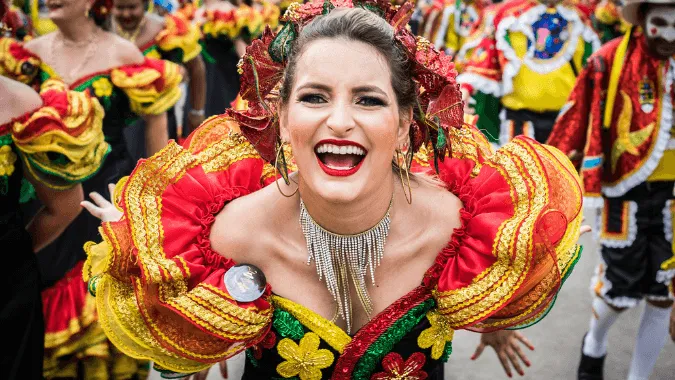5 Facts About Rio de Janeiro Carnival
Rio de Janeiro Carnival dates back to over a century ago, but the event continues to be one of the most trendy celebrations in the world. Here we present 5 things that you (probably) didn't know about the spectacularly extravagant Rio de Janeiro Carnival.
1. The first parade had a royal guest:
What is considered to be the first Carnival parade took place in 1855. A group of intellectuals created a street carnival bloco and marched to São Cristóvão Palace to ask the Royal Family to join them. Dom Pedro II, Brazil’s Emperor, accepted the invitation. The police, however, only started allowing the street carnival parades to take place in 1889, which led Chiquinha Gonzaga to compose the first song written specifically for the carnival celebrations.
[caption id="attachment_7790" align="aligncenter" width="610"] The Brazilian Royal Family was urged to join the festivities from their summer palace / Source[/caption]
The Brazilian Royal Family was urged to join the festivities from their summer palace / Source[/caption] 2. The samba originated from improvisation:
The samba was born close to where the Sambadrome stands today, when a group of friends were improvising with songs at the legendary baiana Tia Ciata. The first samba song, titled “Pelo Telefone” (By the Phone) was recorded in 1917. It wasn’t until 1963 that the carnival celebrations were included in the official Rio de Janeiro tourist calendar, after the samba school Salgueiro paraded about Chica da Silva. The parades used to run through downtown Rio de Janeiro until 1984, when the Sambadrome was built, and now all the official celebrations take place there.
[caption id="attachment_8834" align="aligncenter" width="610"] The Samba School parades are an extravagant affair / Source[/caption]
The Samba School parades are an extravagant affair / Source[/caption] 3. The curse over Portela Samba School:
In 1974, Natalino "Natal" José do Nascimento, the president of the Portela Samba School, urged a few of his senior staff members to assist him with a charm that would enable them to win that year’s contest. It was a very unusual request: they had to spit a mouthful of cachaça (sugar-cane rum) on each float in order to please its spirit guide. Some of them refused, so a curse was brought down on the samba school, meaning they wouldn’t win for at least 30 years.
Sure enough, Portela hasn't won a single contest since, though it still remains the greatest winner of all time with 19 championships.
[caption id="attachment_8833" align="aligncenter" width="610"] If you ask someone from Portela about the curse, they'll probably start knocking on wood / Source[/caption]
If you ask someone from Portela about the curse, they'll probably start knocking on wood / Source[/caption] 4. Street carnival has the most crazy blocos:
- Suvaco do Cristo (Christ’s Armpit)
The name of this street carnival stems from its origins, the neighborhood of Jardim Botânico, beneath the iconic Christ the Redeemer statue. The famous singer and composer Tom Jobim, who lived in the neighborhood, used to complain that his house was filled with moss because it was under ‘Christ’s armpits’.
- Se Melhorar, Afunda
This is the only street carnival group that belongs to two cities: Rio de Janeiro and Niteroi. It starts in Niteroi, crosses the Guanabara Bay on the ferry and continues to party in downtown Rio.
- Blocão
The street carnival group called Blocão, made of the words bloco and cão (dog), is an unusual sight for the pre-carnival celebrations; its members are the pets of people living near Copacabana, and they’re all dressed up (naturally!)
- Caçador de Veados (Deerstalker)
This street carnival no longer exists. It was once a cry of freedom for the gay community, who were forbidden to dress in women’s clothing and were only able to do so during carnival time.
- Gigantes da Lira (The Lyre’s Giants)
This is a street carnival especially for children. It plays kid’s songs to the rhythm of samba and some of the old marchinha; a rather more innocent carnival celebration.
[caption id="attachment_8836" align="aligncenter" width="610"] Woman and her pet dog in a street carnival bloco only for pets in Rio de Janeiro / Source[/caption]
Woman and her pet dog in a street carnival bloco only for pets in Rio de Janeiro / Source[/caption] 5. The Rio de Janeiro Carnival numbers are staggering:
Rio de Janeiro Carnival is widely considered to be the world's greatest celebration - the samba schools invest over $5 million in the parade; over 5 million people celebrate Rio de Janeiro Carnival, 800,000 of whom are tourists; there are over 400 blocos of street samba in the city every year; the oldest and most popular party is the Cordão do Bola Preta, where over 2.3 million people gather annually.
[caption id="attachment_8838" align="aligncenter" width="610"] Inside a street carnival bloco / Source[/caption]
Inside a street carnival bloco / Source[/caption] m
Are you planning a trip to Brazil for Carnival this summer? We enhance South American travel experiences.
[button link="https://www.rdj4u.com/en/" size="medium" target="new" color="orange" rel="nofollow"]Book your Rio de Janeiro tours and activities here[/button]
By Pedro Rocha; Edited by Camilla Day
-
Exciting 4x4 route: São Luís and FortalezafromUS$1,014
-
Vila Gale Mares Resort All InclusivefromUS$100
-
Ecotourism in Chapada DiamantinafromUS$672
-
All inclusive Vila Gelé Cumbuco ResortfromUS$999
-
Full Day Cafayate Tour from SaltafromUS$68
-
Transfer Aeroparque - Buenos AiresfromUS$46
-
-
Transfer Ezeiza - AeroparquefromUS$91
-
-
Excursion to El Chaltén from El CalafatefromUS$153
-
-
-
-
-
-
-
-
-
-
-



